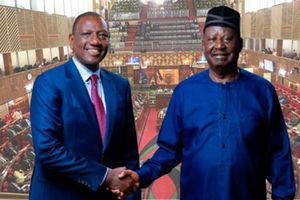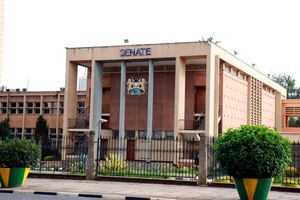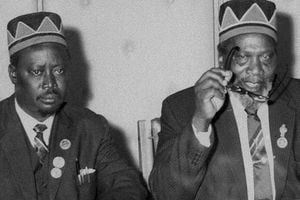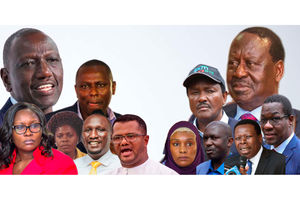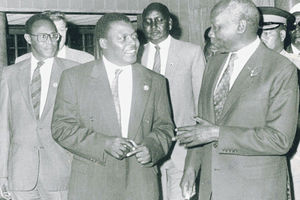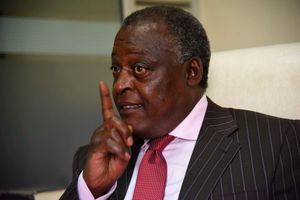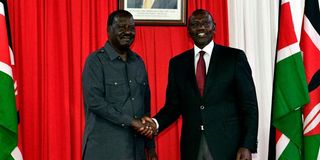
President William Ruto (right) shakes hands with ODM party leader Raila Odinga during the signing of a Memorandum of Understanding between ODM and UDA at Kenyatta International Convention Center in Nairobi on March 07, 2025.
After all the pre-event hype, the formal political cooperation agreement signed between President William Ruto and opposition chief Raila Odinga was something of an anti-climax.
In the period leading up to the unveiling of the deal with a public signing at the Kenyatta International Convention Centre (KICC) on Friday, March 7, the media had been awash with speculative stories about the admission of Mr Odinga’s ODM party into the governing Kenya Kwanza coalition.
There were stories of a major Cabinet reshuffle in which the opposition leader would secure a 50-50 power-sharing agreement and appointment to a powerful Cabinet position that would make him a virtual co-principal in the new power matrix ahead of the formal return of the post of Executive Prime Minister and head of government. To some supporters, these were supposed to be done immediately.
With that came suggestions that the agreement would entail Mr Odinga putting on hold his own or ODM’s quest to capture power at the 2027 elections and supporting Dr Ruto’s bid for a second term.
It was thus something of a damp squib when the Memorandum of Understanding (MoU) signed between the two fell far short of a coalition or a power-sharing pact.
It was notable that the pact was signed between Dr Ruto and Mr Odinga as leaders of their respective political outfits rather than as an expansion of the Kenya Kwanza coalition by admitting ODM into the coalition in which UDA is the dominant party.
Coalition
Indeed, the wording of the agreement emphasised that it was not a coalition, something he went on to emphasise in his remarks after the deal was signed.
Instead, the MoU is a loosely defined cooperation on a host of pending issues, the most significant being a pledge to hasten the implementation of the National Dialogue Committee (Nadco) agreed on to halt the post-2022 election protests organised by Mr Odinga after his fifth abortive presidential bid.
The most crucial element of the Nadco report was indeed to bring back the post of Prime Minister, potentially handing Mr Odinga a share of power. But that would be a long and winding process which, even if assented to by a Kenya Kwanza-ODM majority in Parliament, would still have to go through the rigours of a referendum where passage not be a certainty.
It was in Mr Odinga’s political strongholds, particularly in the Nyanza region, where prospects of the veteran opposition icon securing a share of power were most aggressively sold, and most keenly awaited.
That might also be where there could be a major disappointment as the pact did not immediately award Mr Odinga anything really substantial other than a general agreement to work together towards some largely undefined goals.
It could well be, however, that what was left out of the document might be more important than what was publicly signed.
Other than the agreement on the implementation of the Nadco report, which is not new, the rest of the 10-point agenda was basically a rehash of existing issues which have long been on the table with most of them already covered under the national dialogue framework.
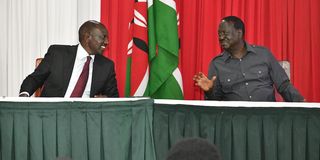
President Willam Ruto and ODM party leader Raila Odinga during the MoU signing event at KICC on March 7, 2025.
They include ensuring inclusivity and a fair share for all, especially minority and marginalised groups; strengthening devolution to improve services on a local level; youth empowerment and employment creation; audit of the national debt; and enhanced efforts in the war against corruption and enhancement and accountability safeguards.
Other issues included restating the rights to freedom of assembly and expression; curbing violent and excessive police responses to lawful protests; and amnesty and compensation for those arrested or injured during past protests.
What was left unsaid was that the pact does implicitly formalise a political alliance that will almost certainly have a major impact come the next elections.
In the lead up to the unveiling of the agreement, appetites were whetted across Mr Odinga’s strongholds where some key figures openly sold prospects of a major re-alignment which would bring the community at the very heart of government, at the expense of the Mt Kenya region that appears to be deserting Dr Ruto after impeachment in October 2024 of Deputy President Rigathi Gachagua.
The Kenya Kwanza administration was depicted as founded on an alliance of Ruto’s Rift Valley and the Mt Kenya regions, together with the presence of the western Kenya strongholds of Prime Cabinet Secretary Musalia Mudavadi and National Assembly Speaker Moses Wetang’ula.
The looming shifts were sold as the exit of Mt Kenya from the centre of power — and entry of Nyanza and other Raila centres of influence such as western Kenya and coastal regions.
There is still room for Dr Ruto to bring in Mr Odinga’s people into positions such as Principal Secretaries, heads of government departments and State corporations and institutions, but all eyes will be on whether or not there will be a Cabinet shakeup to include more allies of Mr Odinga.
The number of cabinet slots is limited by law, so if Dr Ruto wants to bring in more of his new political allies to add to the four appointed on the formation of the broad-based government in July last year, he would have to eject some of those already in office.
Mr Odinga’s acolytes, notably his cabinet nominees John Mbadi (National Treasury), Opiyo Wandayi (Energy), Hassan Joho (Mining), Homa Bay MP and ODM chair Gladys and Homa Bay MP Peter Kaluma have been amongst those most enthusiastically pushing for ejection of the dominant and privileged Mt Kenya from the centre of power in order to make way for historically neglected and marginalised communities. They have openly played up the prospects of a new coalition heading to the 2027 polls.
Dr Ruto and Mr Odinga have, however, been more circumspect in their choice of words, avoiding anything that might stoke the flames in a nation where ethnic tensions bubble just below the surface.
It is, therefore, unlikely that either of them would countenance any actions or rhetoric that would play into the further accelerating Mt Kenya rejection of the government.
Even if he does acknowledge that he is fast losing the support of the populous bloc that provided nearly 50 per cent of his 2027 vote, Dr Ruto would not be so politically naïve as to openly signal that he is done with Mt Kenya.
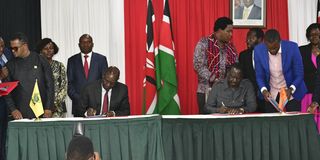
President Willam Ruto and ODM party leader Raila Odinga during the signing of a Memorandum of Understanding between ODM and UDA at Kenyatta International Convention Center in Nairobi on March 07, 2025.
He actually does believe that all is not lost in the region, where retaining between 20 and 30 per cent of his vote could be the difference between victory and defeat.
This was why last December even as he firmed up his links with Mr Odinga, President Ruto made a point of visiting former President Uhuru Kenyatta at his Gatundu home, followed by his propaganda machinery aggressively playing up a narrative that the two allies-turned-foes had mended fences and were embarking on renewal of their broken political alliance.
The media was fed with narratives of Mr Kenyatta taking the opportunity to bring his Mt Kenya allies into government, glossing over the fact that the new appointees — Cabinet Secretaries Mutahi Kagwa (Agriculture), Lee Kinyanjui (Trade) and William Kabogo (ICT), as well as Nderitu Muriithi (Chair of Kenya Revenue Authority) — had not been approached as nominees of the former president.
President Ruto is hopeful that the Mt Kenya brigade, still in his corner, led by Deputy President Kithure KIndiki, the cabinet secretaries and a substantial number of MPs and county governors will be able to stem the exodus driven by Mr Gachagua.
The former DP has transitioned into opposition leadership, where he is teamed with Mr Odinga’s former colleagues in the Azimio coalition led by another former number two Kalonzo Musyoka, DAP-K party leader Eugene Wamalwa and Mr Odinga’s 2022 running-mate Martha Karua.
Mr Kenyatta is also in the opposition mix, with his Jubilee party reportedly backing the presidential aspirations of former Interior CS Fred Matiangi, while quietly tussling with Mr Gachagua for control of the Mt Kenya vote.
The opposition leaders have been publicly pleading with Mr Odinga to abandon Dr Ruto and go back to the fold, but his signing of an MoU with the president serves to indicate that he has made up his mind.
However, the absence of a formal entry into a coalition gives him some wiggle room should circumstances change heading into 2027.
He was under a great deal of pressure from some in his inner circle to go the whole hog and join the Ruto government. But some of his old comrades in the struggle dating back to dissident politics during the single-party era, notably Governors Anyang’ Nyong’o (Kisumu) and James Orengo (Siaya), urged caution. For now, they will be satisfied by the outcome of a loose arrangement which leaves ODM for an easy exit if their expectations from the MoU are not met. Also satisfied will be party Secretary-General Edwin Sifuna, who has been an outspoken critic of any political deal with Dr Ruto which derails ODM’s stab at the presidency in 2027,
At the age of 80, Mr Odinga is obviously ready for his own political exit strategy. His abortive quest for the African Union Commission chairmanship was meant largely to offer him a dignified retirement from the hurly-burly of Kenyan politics, but his return after the African Union Commission poll in Addis Ababa thrust him firmly back onto the scene.
One of the first items on his agenda was a meeting with Dr Ruto at State House Mombasa to ostensibly thank the president for his support in the AU campaigns, but in reality to through the details of the impending political arrangement.
Aides of the two who had been quietly meeting in the background had already prepared a number of scenarios, ranging from a loose cooperation pact, a formal coalition onto a full-fledged merger of their respective parties.
These are some of the alternative documents fed to the media by key personalities from both sides seeking to push their preferred positions.
Mr Odinga then made a show of touring his political strongholds to seek assent for whatever he would do, but it became immediately apparent that no draft documents were shared with the masses or with local politicians, with details kept by a small group of advisers.

President William Ruto (left) makes his remarks after the signing of a Memorandum of Understanding (MoU) between ODM and UDA at the Kenyatta International Convention Center in Nairobi on March 07, 2025.
The eventual agreement suited both Dr Ruto and Mr Odinga. For the veteran opposition leader, apart from wiggle room, a key consideration was concern that he might be seen to have sold his lifelong ideals, and also to have betrayed the Gen Zs whose protests last June shook President Ruto into reaching out for a helping hand.
Insertion in the agreement on amnesty for protestors, respect for human rights and an end to police abductions, as well as matters raised by Gen Z on the cost of living, governance and corruption, were meant to assuage those concerns.
For President Ruto, maintaining the shape of government for now was also a factor, as he was loath to make changes that would impact the roles of Prof Kindiki and Mr Mudavadi or generally upset the existing Kenya Kwanza hierarchy.
These are things that will, however, have to be addressed in the run-up to 2027, but with no set time frame or implementation matrix, there will be no hurry.

